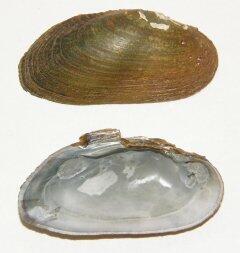







Loading profile. Please wait . . .
Medionidus parvulus (I. Lea, 1860)
Coosa Moccasinshell




Federal Protection: Listed Endangered
State Protection: Endangered
Global Rank: G1?
State Rank: S1
Element Locations Tracked in Biotics: Yes
SWAP 2015 Species of Greatest Conservation Need (SGCN): Yes
SWAP 2025 Species of Greatest Conservation Need (SGCN): Yes
2025 SGCN Priority Tier: Highest Conservation Concern
Element Occurrences (EOs) in Georgia: 6
Habitat Summary for element in Georgia: Shoal areas of large rivers to medium sized creeks with sand and gravel substrates.
Shell profile is sub-rhomboidal to elliptical in outline. Shell rather delicate with a maximum length of approximately 58 mm (2⅜ inches). Anterior margin broadly rounded while posterior margin is bluntly pointed and terminates near the posterioventral margin. Ventral margin is straight to slightly arcuate. Umbos positioned anterior of the middle of the valves and elevated to or just slightly above the hingeline. Posterior ridge is well developed with prominent corrugations present on the posterior slope. The periostracum dull to glossy and yellow to green with fine, irregularly shaped dark rays radiating from the umbo to the margin of the shell. Pseudocardinal teeth are short and triangular while lateral teeth are slightly curved. Nacre color typically bluish-white to gray.
Alabama Moccasinshell (Medionidus acutissimus). The Alabama Moccasinshell and the Coosa Moccasinshell may be difficult to distinguish from one another. However, the Alabama Moccasinshell typically has a more pointed posterior terminus as well as a more angular posterior ridge than the Coosa Moccasinshell.
Typically occupies small streams to large rivers with sand, gravel, or cobble substrates and swift flowing shoal areas.
The diets of unionids are poorly understood but are believed to consist of algae and/or bacteria. Some studies suggest that diets may change throughout the life of a unionid with juveniles collecting organic materials from the substrate though pedal feeding and then developing the ability to filter feed during adulthood (Vaughn and Hakenkamp 2001).
The life history of this species has been poorly studied, but is assumed to be similar to that of other species in the genus Medionidus which brood glochidia over winter and utilize darters (particularly Percina spp.) as host fish.
Surveyors should consider sampling during periods when female individuals are spawning or brooding as this species may have higher detection rates during this period, typically late February to early April. However, since basic life history information for many of Georgia’s unionids is lacking, sampling during periods when closely related species are spawning or brooding may increase probability of detection.
This species is endemic to the upper Mobile River basin of Alabama, Georgia, and Tennessee. In Georgia, this species appears to be restricted to only Holly Creek in the upper Conasauga River watershed and the upper Conasauga River mainstem.
Excess sedimentation due to inadequate riparian buffer zones, development, and agriculture covers suitable habitat and could potentially bury mussels. Poor agricultural practices may also cause eutrophication and degrade water quality. Industrial effluent as well as sewage treatment plant discharges may also be degrading water quality.
| Threat 1 | Threat 2 | Threat 3 | |
|---|---|---|---|
| General Threat | Agriculture & aquaculture | Residential & commercial development | Natural system modifications |
| Specific Threat | None | Commercial & industrial areas | Dams & water management/use |
The Coosa Moccasinshell is not known from any state or federal lands in Georgia. Unlike terrestrial species, the occurrence of an aquatic species on state or federal lands may not eliminate habitat degradation due to the influences of upstream and downstream disturbances.
Minimizing sedimentation in the Conasauga River and its tributaries is a key component to conserving the Coosa Moccasinshell. Restoration of riparian buffers will stabilize banks providing clean gravel and sand substrates for the species. If habitat degradation can be alleviated, reintroduction/augmentation of the Coosa Moccasinshell populations should be explored in order to re-establish viable populations of the species. However, prior to initiating any reintroduction/augmentation projects for the Coosa Moccasinshell, the effective population size of this species should be examined to ensure that these actions would not negatively affect the genetic integrity of the population.
Vaughn C.C. and C.C. Hakenkamp. 2001. The functional role of burrowing bivalves in freshwater ecosystems. Freshwater Biology 46: 1431-1446.
Williams, J.D., A.E. Bogan, and J.T. Garner. 2008. Freshwater mussels of Alabama and the Mobile Basin in Georgia, Mississippi, and Tennessee. The University of Alabama Press, Tuscaloosa.
Jason Wisniewski
2018-03-16